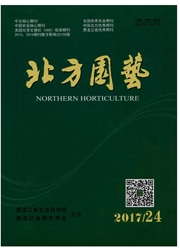

 中文摘要:
中文摘要:
为了引进适合干旱绿洲区气候环境的茎用莴苣品种,寻求适合该地莴苣种植的最佳密度和栽培模式,于2015年在干旱绿洲区高台县绿色蔬菜产业园区进行了莴苣的品种适应性、适宜密度及栽培方式研究。结果表明:供试品种中W4("14-Q64")的综合表现优于其它品种,种植后75d适收,肉质茎长棒形,茎皮最薄,茎肉最厚,商品率最高,单株质量较对照增加了4.56%。同一种植模式,随着种植密度的增大,株高、茎长、茎粗和单株质量均减小;同一种植密度,起垄栽培的株高、茎长、茎粗和单株质量均大于平畦栽培。综合分析表明,"14-Q64"适合在河西干旱绿洲区推广种植,且当地莴苣种植以起垄栽培、播种密度以株行距35cm×30cm为最佳。
 英文摘要:
英文摘要:
The seeds of improved variety of asparagus lettuce,which is one of the main categories of plateau summer vegetables planted in Gansu,was tested by the cultivation in oasis areas(Gaotai county)for varieties' adaptability,planting density and cultivation pattern in 2015.The results showed that compared with the contrast variety,W4(‘14-Q64')was the best of them.W4 growth period was 75 days from sowing to harvest,the fleshy stem was long stick-shaped,its plant weight was over control 4.56%.The commodity rate W4 with the thinnest stem bark(0.6cm)was the highest(98.5%)among the tested varieties.Asparagus plant height,stem length,stem diameter and plant weight decreased with increasing planting density in the same planting pattern.In the same planting density,the plant height,stem length,stem diameter and plant weight of asparagus bed-planting was higher than flat culture.It was illustrated that W4 was the most suitable varieties for cultivation in oasis areas of Gansu corridor,and the best cultivating mode,bed planting with row spacing was30 cm,and individual spacing was 35 cm.
 同期刊论文项目
同期刊论文项目
 同项目期刊论文
同项目期刊论文
 期刊信息
期刊信息
